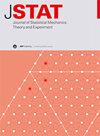利用库普曼算子提取神经网络中的非线性问题
IF 2.2
3区 物理与天体物理
Q2 MECHANICS
Journal of Statistical Mechanics: Theory and Experiment
Pub Date : 2024-07-02
DOI:10.1088/1742-5468/ad5713
引用次数: 0
摘要
非线性在深度神经网络中起着至关重要的作用。在本文中,我们研究了神经网络非线性的重要程度。为此,我们采用了库普曼算子、扩展动态模式分解和张量-训练格式。库普曼算子方法最近在物理学和非线性科学中得到了发展;库普曼算子处理的是可观测空间而非状态空间中的时间演化。由于我们可以用可观测空间中的线性来替代状态空间中的非线性,因此它有望成为理解非线性系统复杂行为的候选方法。在此,我们分析了用于分类问题的学习神经网络。结果表明,在数值实验中,用 Koopman 矩阵替换非线性中间层可以获得足够的准确性。此外,我们还证实,即使在高压缩比的情况下,对 Koopman 矩阵进行剪枝也能获得足够的准确性。这些结果表明,使用库普曼算子方法可以提取神经网络中的某些特征。本文章由计算机程序翻译,如有差异,请以英文原文为准。
Extraction of nonlinearity in neural networks with Koopman operator
Nonlinearity plays a crucial role in deep neural networks. In this paper, we investigate the degree to which the nonlinearity of the neural network is essential. For this purpose, we employ the Koopman operator, extended dynamic mode decomposition, and the tensor-train format. The Koopman operator approach has been recently developed in physics and nonlinear sciences; the Koopman operator deals with the time evolution in the observable space instead of the state space. Since we can replace the nonlinearity in the state space with the linearity in the observable space, it is a hopeful candidate for understanding complex behavior in nonlinear systems. Here, we analyze learned neural networks for the classification problems. As a result, the replacement of the nonlinear middle layers with the Koopman matrix yields enough accuracy in numerical experiments. In addition, we confirm that the pruning of the Koopman matrix gives sufficient accuracy even at high compression ratios. These results indicate the possibility of extracting some features in the neural networks with the Koopman operator approach.
求助全文
通过发布文献求助,成功后即可免费获取论文全文。
去求助
来源期刊
CiteScore
4.50
自引率
12.50%
发文量
210
审稿时长
1.0 months
期刊介绍:
JSTAT is targeted to a broad community interested in different aspects of statistical physics, which are roughly defined by the fields represented in the conferences called ''Statistical Physics''. Submissions from experimentalists working on all the topics which have some ''connection to statistical physics are also strongly encouraged.
The journal covers different topics which correspond to the following keyword sections.
1. Quantum statistical physics, condensed matter, integrable systems
Scientific Directors: Eduardo Fradkin and Giuseppe Mussardo
2. Classical statistical mechanics, equilibrium and non-equilibrium
Scientific Directors: David Mukamel, Matteo Marsili and Giuseppe Mussardo
3. Disordered systems, classical and quantum
Scientific Directors: Eduardo Fradkin and Riccardo Zecchina
4. Interdisciplinary statistical mechanics
Scientific Directors: Matteo Marsili and Riccardo Zecchina
5. Biological modelling and information
Scientific Directors: Matteo Marsili, William Bialek and Riccardo Zecchina

 求助内容:
求助内容: 应助结果提醒方式:
应助结果提醒方式:


